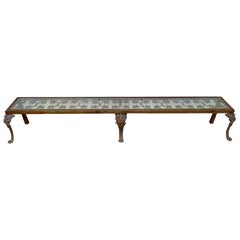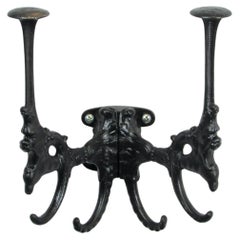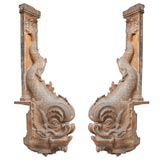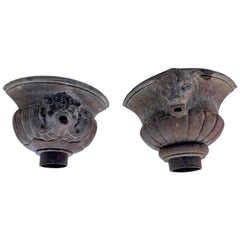Cast Iron Gargoyle
Italian Iron Bench by Gimo Fero
By Gimo Fero
Located in Los Angeles, CA
legs in front are made from original Venation cast iron gargoyles.Gimo with his innovation style and
Category
Vintage 1970s Italian Arts and Crafts Benches
Materials
Iron
19th Century Cast Iron Wall Mounted Hat Rack With Gargoyles
Located in Ferndale, MI
Small wall mounted hat rack with lots of character . Cast iron embellished with gargoyle heads
Category
Antique Late 19th Century American Late Victorian Wall Brackets
Materials
Iron
Recent Sales
Pair of Cast Iron Dolphin Gargoyles.
Located in New Orleans, LA
Impressive pair of sizable cast iron gargoyles in the form of a dolphin. Once components of a
Category
Antique 19th Century English Architectural Elements
Materials
Iron
Set of Two Louis XVI French Parisian Cast Iron Roof Gargoyles from the 1800s
Located in Petaluma, CA
This rare set of two French Parisian antique cast iron roof gargoyles, or gutter hubs, are from the
Category
Antique Late 18th Century French Louis XVI Architectural Elements
Materials
Iron
Antique Arts & Crafts Mission Oak Hat Tree with Gargoyle Form Cast Iron Hooks
Located in Big Flats, NY
Antique Arts & Crafts Mission Oak Hat Tree with Figural Gargoyle Form Cast Iron Hooks, c1920
Category
Early 20th Century Hat Racks and Stands
Materials
Iron
H 73.5 in W 21 in D 21 in
Period Napoleon III Cast Iron Pump or Fountain with Gargoyle Spout
Located in Fayetteville, AR
Napoleon III period cast iron pump with gargoyle spout and original lid, circa 1860. Originally
Category
Antique 1860s French Fountains
Materials
Iron
Matching Cast Iron Gargoyle Water-Spouts
Located in Peekskill, NY
This is a matching pair of architectural details. This type of Griffin gargoyle was typically used
Category
Antique 19th Century Unknown Architectural Elements
Materials
Iron
Pair of 19th Century French Cast Architectural Iron Gargoyles, Large Scale
Located in Stamford, CT
Impressive cast iron gargoyles, depicting winged cats, seated on their haunches with paws raised
Category
Antique Late 19th Century French Belle Époque Architectural Elements
Materials
Iron
Cast Iron Gargoyles
Located in Manchester, GB
Possibly of French origins and fitted into a wall alongside a door lintel. These small antique cast
Category
Antique 1850s French Gothic Revival Architectural Elements
Materials
Iron
Pair of Italian Gargoyle Sconces
Located in West Palm Beach, FL
Cast iron gargoyle torso with 2 arms.
Category
Early 20th Century Italian Wall Lights and Sconces
Materials
Wrought Iron
New York City Gaurdian Gargoyles
Located in New York, NY
American, New York City, 19th century, cast iron gargoyles. These were often used in that period as
Category
Antique 19th Century Statues
Materials
Iron
Wonderful 19th Century Stone Fountain with Cast-Iron Dolphins & Medicis Vases
Located in Isle sur la Sorgue, FR
dolphins placed in carved niches and sitting on wide molded foot blocks. The cast iron gargoyle in the
Category
Antique 19th Century French Fountains
Materials
Limestone
H 86.62 in W 236.23 in D 70.87 in
Cast Iron Vase with Gargoyle Handles signed Alfred Corneau
Located in Hudson, NY
Cast Iron Vase with Gargoyle Handles signed Alfred Corneau
Category
Antique 19th Century French Urns
Materials
Iron
French Andirons with Gargoyles
Located in West Palm Beach, FL
Cast and wrought iron
Category
Vintage 1940s French Andirons
Materials
Wrought Iron
Val D'osne Gargoyle Urns
By Val D'Osne Foundry
Located in New York, NY
French, mid-nineteenth century cast iron urns with exceptional gargoyles and guilloche modeling
Category
Antique 19th Century French Urns
Materials
Iron
Get Updated with New Arrivals
Save "Cast Iron Gargoyle", and we’ll notify you when there are new listings in this category.
Questions About Cast Iron Gargoyle
- 1stDibs ExpertMay 3, 2024The difference between iron and cast iron comes down to content. Iron is generally pure iron, a chemical element that is a solid metal at room temperature. Cast iron is a mix of iron, carbon, silicon, manganese, sulfur, phosphorus and other elements. Both iron and cast iron can be used to produce furniture, cookware, decorative objects and other items. Generally, cast iron is heavier than iron. Shop an assortment of iron and cast iron pieces on 1stDibs.
- What are cast iron columns?1 Answer1stDibs ExpertMay 5, 2023Cast iron columns are vertical supports produced out of cast iron, a material made from iron and alloys with a carbon content of more than two percent. During the 19th century, cast iron columns were used in architecture. Today, they primarily function as decorative objects. Shop a range of cast iron columns on 1stDibs.
- Who invented cast iron?1 Answer1stDibs ExpertMay 3, 2024The name of the person who invented cast iron is unknown. However, anthropologists and archaeologists have determined that the ancient Chinese were the first to develop it. The earliest known examples of cast iron date back to the 6th century B.C. Cast iron production didn't begin in Europe until the 14th century A.D. Shop a collection of cast iron furniture and decorative objects on 1stDibs.
- 1stDibs ExpertMarch 31, 2023Cast iron is often used for benches because of its characteristics. Its strength makes it well-suited to support the weight of two or more adults, and its hardness allows it to resist damage due to weather exposure. Shop a range of cast iron benches on 1stDibs.
- 1stDibs ExpertApril 5, 2022Cast iron is frequently used for fireplaces due to its properties. The metal is highly durable, allowing it to hold up to the effects of frequent use. It also readily conducts heat to help warm up interiors. You'll find a variety of cast iron fireplaces on 1stDibs.
- When were cast iron beds made?1 Answer1stDibs ExpertFebruary 22, 2021Cast iron beds were made starting in the 1850s. These types of beds were handmade until World War I through the use of molds.
- Does cast-iron furniture rust?1 Answer1stDibs ExpertSeptember 25, 2019
Yes, cast-iron furniture rusts.
- How do I hang a cast iron bell?1 Answer1stDibs ExpertMarch 22, 2022How to hang a cast iron bell depends on the style. Some cast iron bells have loops at the top that you can hang from a hook anchored onto your desired mounting surface. Others have brackets or frames that you can secure with mounting screws. On 1stDibs, shop a selection of cast iron bells.
- Are cast iron columns hollow?1 Answer1stDibs ExpertMarch 31, 2023Whether cast iron columns are hollow depends on the piece. Most cast iron columns are hollow due to the manner of crafting, but some are solid. On 1stDibs, find a selection of columns.
- 1stDibs ExpertFebruary 17, 2023Yes, you can generally use cast iron as a planter because the material is durable and sturdy. However, you may need to drill drainage holes in a cast iron piece that wasn't intended to function as a planter to allow excess water to exit the vessel. On 1stDibs, find a selection of cast iron planters.
- Do cast iron tables rust?1 Answer1stDibs ExpertMay 5, 2023Yes, cast iron tables can rust. Pieces are more likely to develop rust when exposed to humidity, such as in bathrooms or outdoor living spaces in coastal areas. Wiping surfaces clean regularly and touching up scratches and chips can reduce the risk of rust. On 1stDibs, shop a selection of cast iron tables.
- Do cast iron Firebacks work?1 Answer1stDibs ExpertAugust 24, 2021Yes, cast iron firebacks are quite sturdy and work really well. As they are made of solid iron, it's a challenge to move and place them. Given that, cast iron firebacks are the best protection for the back wall of the fireplace. Find a variety of firebacks on 1stDibs.
- 1stDibs ExpertSeptember 25, 2019
To keep a piece made of cast iron from rusting, place it in a cool, dry space with good air circulation.
- 1stDibs ExpertAugust 17, 2021Cast iron trivets are used for many things but are especially ideal for slow cooking meat. They can prop up food in Dutch ovens to prevent burning and increase heat distribution.
- 1stDibs ExpertMarch 22, 2022Cast iron doorstops originated in the late 18th century. Osbourn Dursey invented the first doorstop in 1878. Decorative cast iron stops became popular in the 1920s and remained so throughout World War II. On 1stDibs, shop a variety of antique cast iron doorstops.
- 1stDibs ExpertSeptember 25, 2019
Cast iron is stronger than steel.
- 1stDibs ExpertMarch 22, 2022A cast iron fireplace insert is a firebox that fits into an existing fireplace surround. The insert is made of cast iron, a type of iron that is more than 2 percent carbon. Cast iron is highly durable and very resistant to the effects of heat. You'll find a selection of cast iron fireplace inserts on 1stDibs.
- 1stDibs ExpertSeptember 25, 2019
Unlike cast iron, wrought iron is not brittle and will bend rather than break. Wrought ironwork is produced with a hammer and anvil and tends to be more intricate than cast ironwork, which is characterized by repetitive designs that can be carved into a wooden pattern and cast.
- 1stDibs ExpertJune 30, 2023To tell if a cast iron doorstop is valuable, always look for original paint. Any that have been repainted or repaired will have diminished in value. You can also use online resources to try and research items, but the best way to find out if a cast iron doorstop is worth anything is to consult a certified appraiser. An experienced professional can evaluate the condition, determine the maker and research the piece to assign an approximate value. On 1stDibs, find a range of doorstops.
- 1stDibs ExpertApril 5, 2022The weight of a cast iron bench depends mainly on the size of the bench and whether other materials, such as wood are used in it. Cast iron weighs 0.26 pounds per cubic inch, making it quite a heavy material, and ideal for outdoor furniture that you want to ensure can weather heavy winds and precipitation. Shop an array of cast iron benches on 1stDibs.



